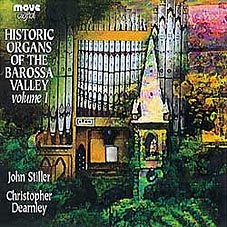St Thomas' Lutheran Church,
cnr Stockwell & Duck Ponds Rds, Stockwell
B c.1850 J.C.A. Kruger for Bethany Lutheran Church;
installed & enlarged present location 1929 J.E. Dodd;
restored 1981 Roger Jones; missing pipework replaced 1987 Roger Jones.
1 manual, 7 speaking stops, 1 coupler, tracker. Man: 8.8.8.4.4.2. Ped: 16.

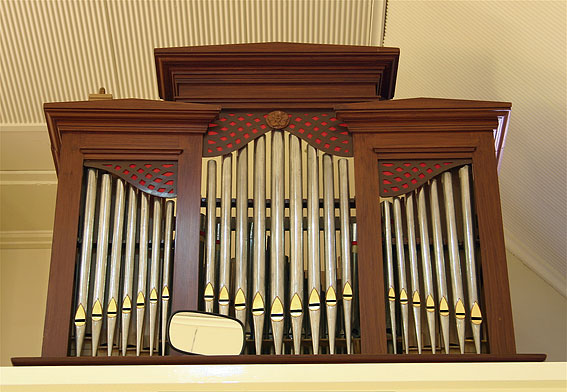
Recordings
John Stiller plays:
From Historic Organs of the Barossa Valley Volume 1 (1995) CD booklet:
Johann Carl August Krüger was born near Berlin in 1814 and migrated to South Australia in 1848. He only lived in SA for a couple of years before moving to Victoria. It appears that he built two organs when in SA but only this organ survives. The pipework may have been built by him, his metal pipes possibly being the first made in SA.
This organ was built c. 1850 and it was originally located in the west end gallery of Herberge Christi Lutheran Church, Bethany. While there it had a peadlboard and a pedal stop of 8' pitch was added to it as well as some repair work in 1880 and 1899. The organ was moved to St Thomas' Lutheran Church, Stockwell in 1928/9 and various alterations were made to it by the Adelaide organbuilder J E Dodd at this time. These changes included the transposition of the pitch one semitone lower and the changing of the 8' pedal stop to 16'. By 1980 deterioration had made the instrument virtually unplayable. It was restored by Roger Jones in 1982 and its tonal excellence has been revived.
The organ consists of a single manual of four octaves and a pedalboard of one stop.
The specification comes from the 1986 OHTA Conference booklet.
| Manual Open Diapason Gedact Viol di Gamba Principal Flute Fifteenth Pedal Bourdon |
8 8 8 4 4 2 16 |
(gvd) (spare slide) |
Compass 49/30
location in west gallery
Restored specification (1982 Roger Jones) from CD booklet:
| Manual Prinzipal Holzgedact Salicional Octave Spitzflöte Superoktave Pedal Subbass |
8 8 8 4 4 2 16 |
(gvd) TC (provided R Jones 1982 on spare/separate slide) added 1929 J E Dodd |
From
the 2009 OHTA Conference Book,
David Shield writes: The
organ at Stockwell came from Bethany but its provenance is not absolute. Comparison with an instrument now in
the museum at Tanunda probably confirms that the same builder, J.C.A. Krüger,
an early settler of the Western District of Victoria, who resided briefly in
South Australia, made it. The
Lutheran church of St Thomas, the doubting apostle, acquired the organ in 1938.
Stockwell
was a thriving township until the main road bi-passed it in 1885. A resting place on the stock route, by
1856 it had two stores with a third in 1875. In 1857 came a post office and the Stockwell Inn. In 1882, a maternity hospital was
opened serving its purpose until 1939 when the Angaston hospital opened.1 The town itself had resulted from the
sale of a subdivision of land in April 1854 owned by Samuel Stockwell, an
English migrant butcher and colt breaker.
The previous year he had purchased land near the creek to erect a steam
mill, completed, in 1854 by J. Kunoth and Edward Clements.2 The
first church serving the settlers was also a Christian school situated to the
north-east of the town. The Salem
congregation, which had used the building for worship each Wednesday evening
and Sundays since 1856, finally outgrew the facility. Only 11 feet wide and 42 feet long (3.36m x 12.8m), with
additional rooms on the southern end used for residential purposes, it was no
longer adequate. In Pastor
Hossfeld’s words, “the little clay church became dilapidated under the growing
tooth of time and the necessity of a new church made itself felt more and
more.”3 Thus the
decision to build the current church in 1903. Some
doubt had apparently been expressed as to whether a church would be built in
Stockwell and, as folklore has it, that led to the naming of the church.4 The doubts were unfounded for on 7
August 1904 the church of St Thomas was dedicated. With a vestry added to the rear, the church itself was 45
feet in length, 35 feet wide, with walls 14 ½ feet high (13.73m x 10.68m
x 4.42m) to accommodate 250 persons. 25
years later preparations were being made to celebrate the occasion. Decisions were made to build a tower,
provide new furnishings of altar, pulpit and lectern, and repaint the interior. The Boer family who now owned the mill
presented a new bell poured in Bochum Germany (Tone E Measurements 30” x
23”). The day of celebration was
to be Sunday 10 August 1929.
Although earlier histories suggest the organ came from Bethany at this
time,5 there is no mention of it. In fact, it was to be the congregation’s next project,
realised nine years later with a dedication on 12 June 1938. J.E.
Dodd had acquired the organ from Bethany in 1929 as part payment for the
installation of their new instrument.
He allowed £75 for it.
Though much has been written, its origins are obscure6. From comparison with another
instrument, now in the museum at Tanunda, it is acknowledged to be the work of
J.C.A. Krüger prior to his leaving for Western Victoria in May 1855. The earliest records of it being
located at Bethany come from financial records that indicate it was subject to
frequent repair from as early as 1861.
By 1928 the Bethany congregation opted to purchase a new instrument rather
than persevere with the repair of the old. Krüger
had arrived in 1848, the year that Pastor Meyer was called to assist Frietszche
at Bethany. Listed as an organist
and organbuilder, with wife and four children, it has been generally accepted
that Krüger settled at Hoffnungstahl in the Hundred of Barossa. Surprisingly, perhaps, he did not seem
to have owned any land. In 1851
the District Road Board for the Hundred of Barossa charged a levy on the basis
of the acreages held including those of the Germans at Hoffnungstahl for the
purpose of road construction.
Krüger’s name is not listed7 On the basis of a questionable pasturage licence issued for
the year ending 31 March 1851, he is said to have settled down to farming. The licence was to pasture 172 cattle
on government land in the Hundred of Moorooroo to the north, and was issued in
the name of Kreiger.8
For an organist with a young family it seems a tall order to take on the
vocation of a herdsman for so many cattle and still find time to construct one
if not two pipe organs.9
Even the family history indicates his being a small farmer to be more
appropriate. He “would have
started from scratch, building a home, clearing the land and building fences to
keep stock from straying.” On
moving to Victoria he developed an interest in wool production and had 48
partly cultivated acres at Lake Linlithgow.10 Here he is acknowledged to have built
an organ for Hochkirch that is now located at the museum in Tanunda.11 By
comparison of Stockwell to Hochkirch, Stiller concluded the organs shared the
same builder. Similarities were to
be found in all areas of pipework, action, soundboard, console and case. Most of the differences were attributed
to Dodd’s alterations in 1929. In
the first place the general design of the case is similar though the display
pipe grouping diverges slightly with flats of 7:7:7 and 7:9:7. The mouth formation of the metal pipes,
shape of wooden pipe stoppers, and workmanship of wooden pipe mouths, is
exactly the same. In either
instrument ears are not present on open cylindrical pipes and the wooden pipes
are not racked. The action,
rollers, roller bearings, roller arms, and backfalls, share the same shape and
design. Both organs have soundboards
without bottom boards, and both have a clamp which contained a Viola di Gamba
8. Both organs have a compass of
49 notes C-c3. Stiller
found difference in roller board frame shape, construction of the bellows and
symmetry of soundboards. Stop
action varied between the two organs as did the shape of keyboard cheeks, style
of stopknob, and lettering of stop labels. The organ benches also differed in style. His conclusion was that the organ at
Stockwell was definitely built by Krüger.12 Over
its lifetime, the organ has received a great deal of attention. Early records indicate the organ at
Bethany required much repair although what form that took is unknown. The financial records show expenses for
1861, 1864, and 1867. Daniel Lemke
carried out further repairs in 1874 and 1875, and in February 1879 he gave it
an overhaul that required 11 days.
There is evidence that Rendall may have also undertaken some work in
1885 as his name is scratched on the lead weight of the keyboard with that
date.13 Theo Geyer also
undertook repair work in 1899 and Stiller suggests it was he who added the
pedal-board.14 Stiller
also noted that the pitch of the organ had been lowered. In 1918 the old organ was again
thoroughly repaired and of course renovated before coming to Stockwell in 1938.15 Assuming Dodd lowered the pitch, this
work may have been done by him at either time. From at least 1912, Dodd’s instruments were pitched to the
New Philharmonic standard, see, for example, Parkside Baptist Church, though
the work is more likely to have been undertaken, as also the stop knobs, with
the renovations of 1929. By
1947 the organ was still being pumped by hand and the fee for pumping was
raised to 1/-. Because it was too
expensive to purchase, an electric blower was constructed and installed by
members of the congregation the following year. In 1952 the organ was again in need of repair and the Dodd
firm was asked to “have a look at
it”. After extensive repairs in
1960 by L S. Waters costing £375, “the organ was again in fine tune”.16 By
1980, the organ was again in a state of disrepair. Rather than see the organ destroyed John Stiller prevailed
upon the Church authorities to have it restored. Roger Jones undertook the work for a cost of $3,500, and the
organ was rededicated on 7 March 1982.
The pipework and casework were restored with a Lutheran emblem carved to
fit the new central pipeshade.
Previously anglicised, possibly by Dodd, the stopknobs were engraved in
German with German script. The
pedal Bourdon remained pneumatic (with mechanical manual to pedal
coupling.). Wind pressure was
reduced from 2 ⅞” to 2 ½ inches. The pipework for the Viol di Gamba was missing in 1979
giving a spare slide. In memory of
Mrs Gladys Bartsch, organist for 50 years, Jones added a new 8’Salicional rank
in 1982.17 J.C.A. Krüger c.1850 1 manual and pedal, 7 speaking stops, mechanical
and pneumatic action The
first specification shows the stop names recorded by John Stiller before the
1982 restoration: MANUAL Open Diapason 8 gvd Gedact 8 Viol di Gamba 8 (spare slide) Principal 4 Flute 4 Fifteenth 2 PEDAL Bourdon 16 Compass 49/30 Attached console Location: west gallery The second specification
shows the stop names following the 1982 restoration: MANUAL Prinzipal 8 gvd.bass Holzgedact 8 Salicional 8 TC (provided R Jones
1982 on spare slide) Octave 4 Spitzflöte 4 Superoktave 2 PEDAL Subbass 16 added 1929 J.E. Dodd Pedal Coppel 1 St Thomas Lutheran
Church Stockwell Celebrating the 100th Anniversary Sunday 8 August
2004, pp.5-7 2 The surname is inserted
here, as there may be a connection with the organ at Rosedale, which see. 3 Evangelical Lutheran
St Thomas Church of Stockwell Jubilee 1904-1954 November 14th 1954, .p8 4 Ibid., p.9 5 Kudinoff, M., ‘Pioneer
organ in the Barossa Valley, S.A’, OHTA News vol 5, no 4 (October 1981), p.7 6 see also section on
Herberge Christi Church at Bethany. 7 South Australian
Government Gazette, 1 May 1851,
pp.315-316 8 Ibid.; Adelaide
Times, 11 May 1850; Register, 11 May 1850, p. 3.3/4 9 It is said that Krüger
made an organ for Hoffnungstahl that was moved to St Jacobi Lyndoch, and was
acquired by Theo Geyer in 1930.
Nothing more is known and this information relies on an old man’s
memories published in 1938. Jurs
Memoirs, Kirchen Blatt, 22 August
1938, p.264 10 Johann Carl August
Krüger and his Descendants in Australia 1848-1980 (1981), pp.11, 13 11 For details see
section on the Krüger organ at the Tanunda museum 12 Stiller, J., Documentation
St Thomas Lutheran Stockwell 22
December 1978, 23 March 1979,10 January 1980 13 Noted by Lutz, M., The Work Praises The Man (1996), p.6.
The extension of bass pipes and pedal clavier to the organ after 1929
can hardly be attributed to Rendall.
His last organ in South Australia before moving to NSW was built for
G.S. Hale that same year, 1885.
See also: Marananga. 14 On the back of the
music desk is the pencilled inscription “Repaired April 1899 TG”. Stiller, J, op cit, p.2.
Dodd may have added the pneumatic action 15 150th Anniversary
of Herberge Christi Congregation and Settlement of Bethany 15 March 1992, p.14.
On the assumption that Dodd undertook the repair, the firm’s records for
the period are missing so no details are known 16 St Thomas Church
Stockwell Celebrating the 100th Anniversary Sunday August 8 2004, pp.29, 30, 32. There appears to be some confusion as to dates. Dodd aged 95 had died on 30 January
1952. All records from Waters have
been destroyed so what was undertaken is unknown. 17 Kudinoff, M., op.cit.,
pp.7-11, 14, 15; memorial to Gladys Bartsch noted 2009.
Pedal Coppel
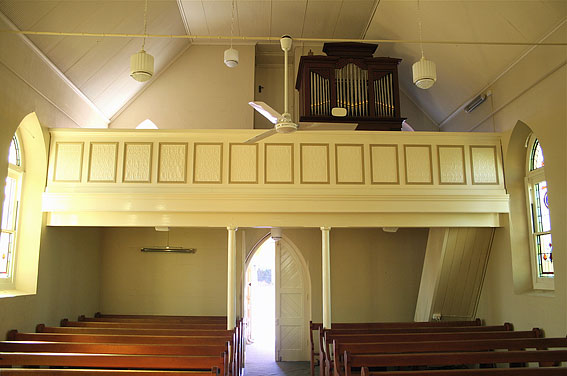
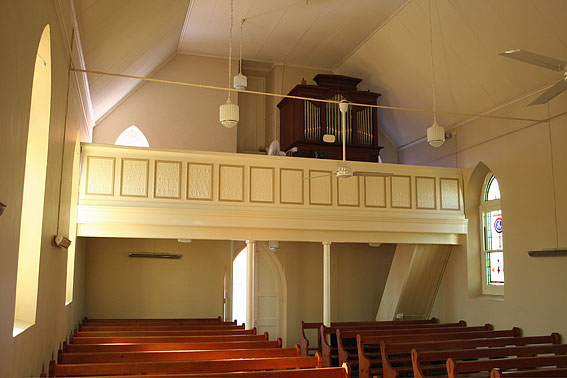
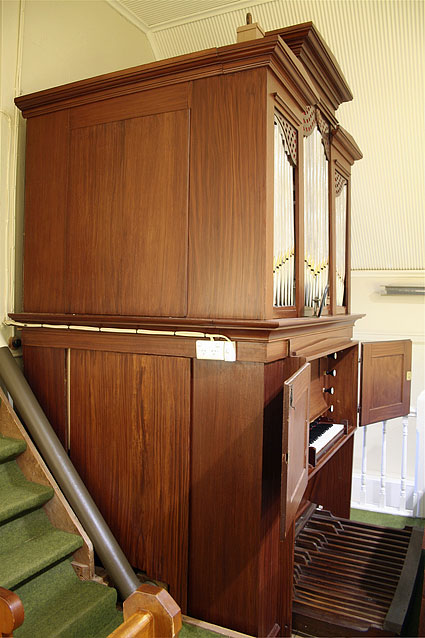
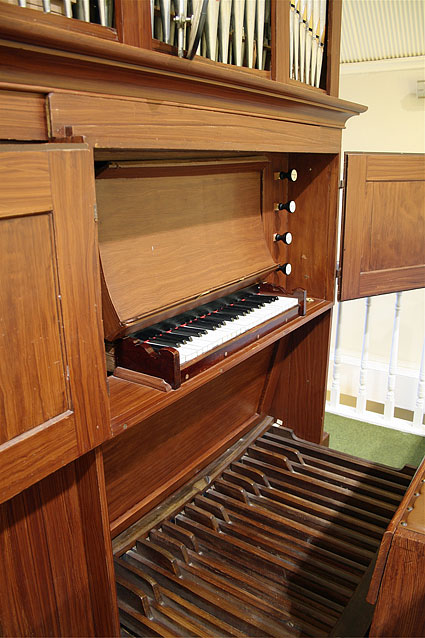
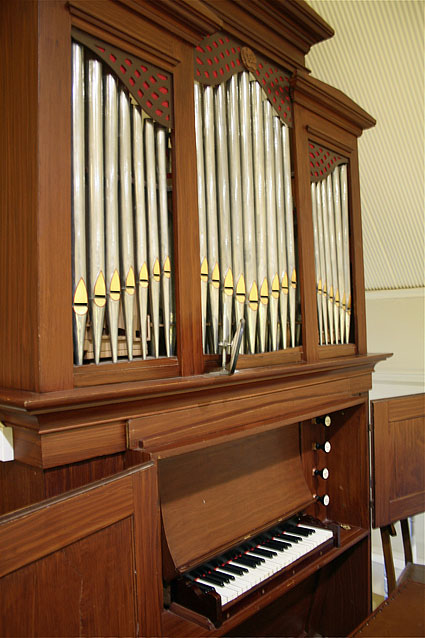
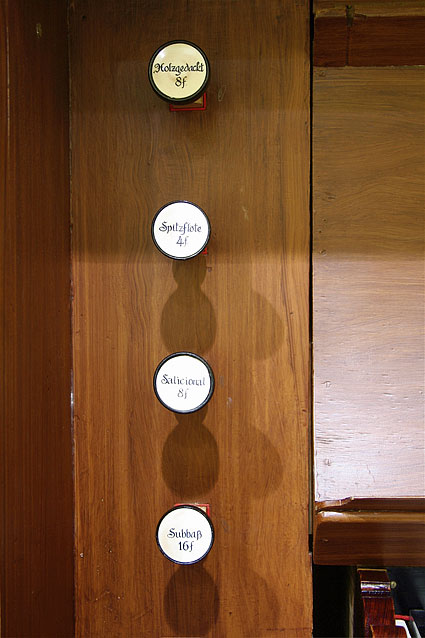
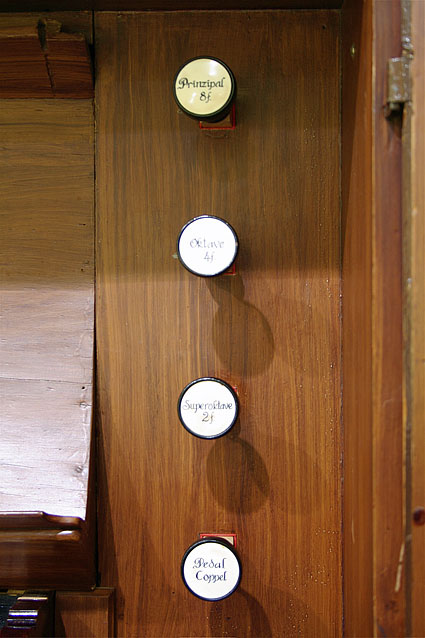


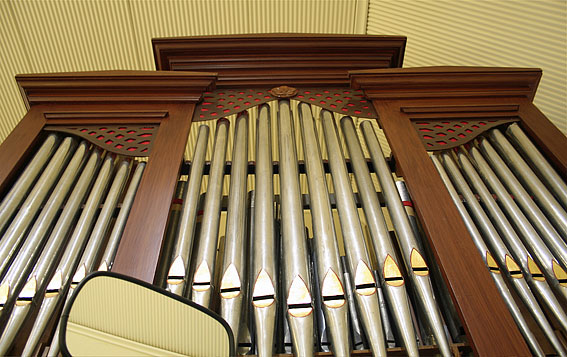
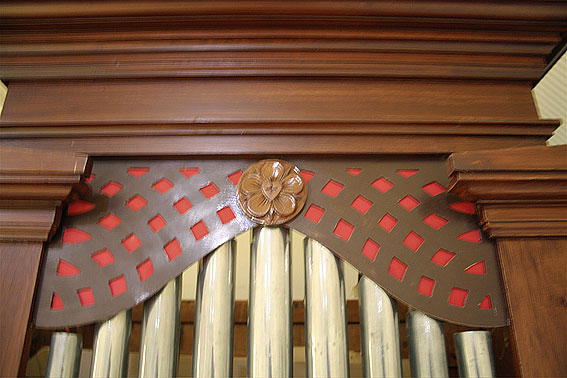
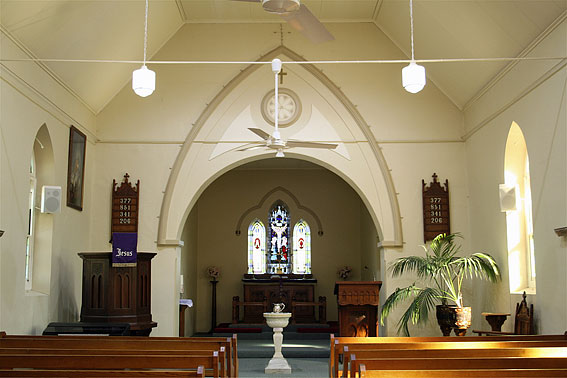
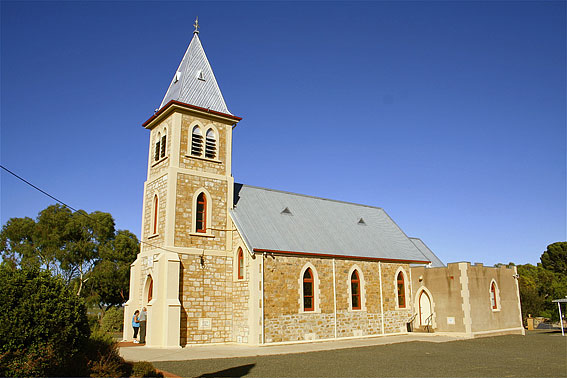
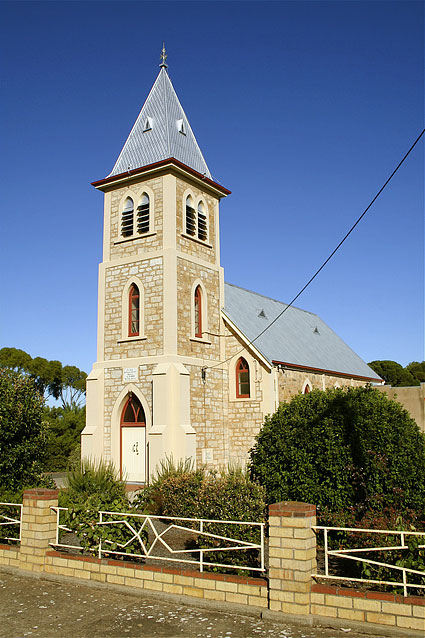
Photos: Trevor Bunning (March 2009)
